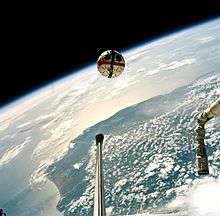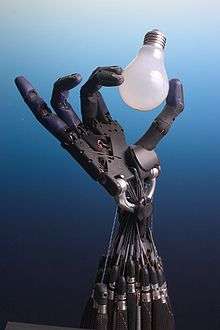Robotic spacecraft

A robotic spacecraft is an uncrewed spacecraft, usually under telerobotic control. A robotic spacecraft designed to make scientific research measurements is often called a space probe. Many space missions are more suited to telerobotic rather than crewed operation, due to lower cost and lower risk factors. In addition, some planetary destinations such as Venus or the vicinity of Jupiter are too hostile for human survival, given current technology. Outer planets such as Saturn, Uranus, and Neptune are too distant to reach with current crewed spaceflight technology, so telerobotic probes are the only way to explore them.
Many artificial satellites are robotic spacecraft, as are many landers and rovers.
History


The first robotic spacecraft was launched by the Soviet Union (USSR) on 22 July 1951, a suborbital flight carrying two dogs Dezik and Tsygan.[1] Four other such flights were made through the fall of 1951.
The first artificial satellite, Sputnik 1, was put into a 215-by-939-kilometer (116 by 507 nmi) Earth orbit by the USSR) on 4 October 1957. On 3 November 1957, the USSR orbited Sputnik 2. Weighing 113 kilograms (249 lb), Sputnik 2 carried the first living animal into orbit, the dog Laika.[2] Since the satellite was not designed to detach from its launch vehicle's upper stage, the total mass in orbit was 508.3 kilograms (1,121 lb).[3]
In a close race with the Soviets, the United States launched its first artificial satellite, Explorer 1, into a 193-by-1,373-nautical-mile (357 by 2,543 km) orbit on 31 January 1958. Explorer I was a 80.75-inch (205.1 cm) long by 6.00-inch (15.2 cm) diameter cyllynder weighing 30.8 pounds (14.0 kg), compared to Sputnik 1, a 58-centimeter (23 in) sphere which weighed 83.6 kilograms (184 lb). Explorer 1 carried sensors which confirmed the existence of the Van Allen belts, a major scientific discovery at the time, while Sputnik 1 carried no scientific sensors. On 17 March 1958, the US orbited its second satellite, Vanguard 1, which was about the size of a grapefruit, and remains in a 360-by-2,080-nautical-mile (670 by 3,850 km) orbit as of 2016.
Nine other countries have successfully launched satellites using their own launch vehicles: France (1965), Australia (1967), Japan and China (1970), the United Kingdom (1971), India (1980), Israel (1988), Iran (2009), and North Korea (2012).[4]
Design
In spacecraft design, the United States Air Force considers a vehicle to consist of the mission payload and the bus (or platform). The bus provides physical structure, thermal control, electrical power, attitude control and telemetry, tracking and commanding.[5]
JPL divides the "flight system" of a spacecraft into subsystems.[6] These include:
Structure
This is the physical backbone structure. It:
- provides overall mechanical integrity of the spacecraft
- ensures spacecraft components are supported and can withstand launch loads
Data handling
This is sometimes referred to as the command and data subsystem. It is often responsible for:
- command sequence storage
- maintaining the spacecraft clock
- collecting and reporting spacecraft telemetry data (e.g. spacecraft health)
- collecting and reporting mission data (e.g. photographic images)
Attitude determination and control
This system is mainly responsible for the correct spacecraft's orientation in space (attitude) despite external disturbance-gravity gradient effects, magnetic-field torques, solar radiation and aerodynamic drag; in addition it may be required to reposition movable parts, such as antennas and solar arrays.[7]
Telecommunications
Components in the telecommunications subsystem include radio antennas, transmitters and receivers. These may be used to communicate with ground stations on Earth, or with other spacecraft.[8]
Electrical power
The supply of electric power on spacecraft generally come from photovoltaic (solar) cells or from a radioisotope thermoelectric generator. Other components of the subsystem include batteries for storing power and distribution circuitry that connects components to the power sources.[9]
Temperature control and protection from the environment
Spacecraft are often protected from temperature fluctuations with insulation. Some spacecraft use mirrors and sunshades for additional protection from solar heating. They also often need shielding from micrometeoroids and orbital debris.[10]
Propulsion
Mechanical devices
Mechanical components often need to be moved for deployment after launch or prior to landing. In addition to the use of motors, many one-time movements are controlled by pyrotechnic devices.[11]
Control
Robotic spacecraft use telemetry to radio back to Earth acquired data and vehicle status information. Although generally referred to as "remotely controlled" or "telerobotic", the earliest orbital spacecraft – such as Sputnik 1 and Explorer 1 – did not receive control signals from Earth. Soon after these first spacecraft, command systems were developed to allow remote control from the ground. Increased autonomy is important for distant probes where the light travel time prevents rapid decision and control from Earth. Newer probes such as Cassini–Huygens and the Mars Exploration Rovers are highly autonomous and use on-board computers to operate independently for extended periods of time.[12][13]
Space probes

A space probe is a scientific space exploration mission in which a spacecraft leaves Earth and explores space. It may approach the Moon, enter interplanetary, flyby or orbit other bodies, or approach interstellar space.
Robotic spacecraft service vehicles

- MDA Space Infrastructure Servicing vehicle — an in-space refueling depot and service spacecraft for communication satellites in geosynchronous orbit. Launch planned for 2015.[14]
- Mission Extension Vehicle is an alternative approach that does not utilize in-space RCS fuel transfer. Rather, it would connect to the target satellite in the same way as MDA SIS, and then use "its own thrusters to supply attitude control for the target."[15]
See also
- Astrobotic Technology
- Geosynchronous satellite
- Human spaceflight
- Space observatory
- Timeline of Solar System exploration
- Automated cargo spacecraft
References
- ↑ Asif Siddiqi, Sputnik and the Soviet Space Challenge, University Press of Florida, 2003, ISBN 081302627X, p. 96
- ↑ Dr. David Whitehouse (2002-10-28). "First dog in space died within hours". BBC NEWS World Edition. Archived from the original on 2002-10-28. Retrieved 2013-05-10.
The animal, launched on a one-way trip on board Sputnik 2 in November 1957, was said to have died painlessly in orbit about a week after blast-off. Now, it has been revealed she died from overheating and panic just a few hours after the mission started.
- ↑ "Sputnik 2, Russian Space Web". 3 November 2012.
- ↑ Bob Christy (2013-05-10). "Firsts in Space: Firsts in Space". Zarya. Archived from the original on 2013-05-10. Retrieved 2013-05-10.
- ↑ "Air University Space Primer, Chapter 10 – Spacecraft Design, Structure And Operation" (PDF). USAF.
- ↑ "Chapter 11. Typical Onboard Systems". JPL.
- ↑ Wiley J. Larson; James R. Wertz(1999). Space Mission Analysis and Design, 3rd edition. Microcosm. pp. 354. ISBN 978-1-881883-10-4,
- ↑ LU. K. KHODAREV (1979). "Space Communications". The Great Soviet Encyclopedia. Archived from the original on 1979. Retrieved 2013-05-10.
The transmission of information between the earth and spacecraft, between two or more points on the earth via spacecraft or using artificial means located in space (a belt of needles, a cloud of ionized particles, and so on), and between two or more spacecraft.
- ↑ Wiley J. Larson; James R. Wertz(1999). Space Mission Analysis and Design, 3rd edition. Microcosm. pp. 409. ISBN 978-1-881883-10-4,
- ↑ "Micrometeoroid and Orbital Debris (MMOD) Protection" (PDF). NASA. Archived from the original (PDF) on 2009-10-29. Retrieved 2013-05-10.
- ↑ Wiley J. Larson; James R. Wertz(1999). Space Mission Analysis and Design, 3rd edition. Microcosm. pp. 460. ISBN 978-1-881883-10-4,
- ↑ K. Schilling; W. Flury (1989-04-11). "AUTONOMY AND ON-BOARD MISSION MANAGEMENT ASPECTS FOR THE CASSINI-TITAN PROBE" (PDF). ATHENA MARS EXPLORATION ROVERS. Archived from the original (PDF) on 1989-04-11. Retrieved 2013-05-10.
Current space missions exhibit a rapid growth in the requirements for on-board autonomy. This is the result of increases in mission complexity, intensity of mission activity and mission duration. In addition, for interplanetary spacecraft, the operations are characterized by complicated ground control access, due to the large distances and the relevant solar system environment[…] To handle these problemsn, the spacecraft design has to include some form of autonomous control capability.
- ↑ "Frequently Asked Questions (Athena for kids): Q) Is the rover controlled by itself or controlled by scientists on Earth?" (PDF). ATHENA MARS EXPLORATION ROVERS. 2005. Archived from the original (PDF) on 2009-10-29. Retrieved 2013-05-10.
Communication with Earth is only twice per sol (martian day) so the rover is on its own (autonomous) for much of its journey across the martian landscape. Scientists send commands to the rover in a morning "uplink" and gather data in an afternoon "downlink." During an uplink, the rover is told where to go, but not exactly how to get there. Instead, the command contains the coordinates of waypoints toward a desired destination. The rover must navigate from waypoint to waypoint without human help. The rover has to use its "brain" and its "eyes" for these instances. The "brain" of each rover is the onboard computer software that tells the rover how to navigate based on what the Hazcams (hazard avoidance cameras) see. It is programmed with a given set of responses to a given set of circumstances. This is called "autonomy and hazard avoidance."
- ↑ "Intelsat Picks MacDonald, Dettwiler and Associates Ltd. for Satellite Servicing". press release. CNW Group. Retrieved 2011-03-15.
MDA plans to launch its Space Infrastructure Servicing ("SIS") vehicle into near geosynchronous orbit, where it will service commercial and government satellites in need of additional fuel, re-positioning or other maintenance. ... MDA and Intelsat will work together to finalize specifications and other requirements over the next six months before both parties authorize the build phase of the program. The first refueling mission is to be available 3.5 years following the commencement of the build phase.
- ↑ Morring, Frank, Jr. (2011-03-22). "An End To Space Trash?". Aviation Week. Retrieved 2011-03-21.
ViviSat, a new 50-50 joint venture of U.S. Space and ATK, is marketing a satellite-refueling spacecraft that connects to a target spacecraft using the same probe-in-the-kick-motor approach as MDA, but does not transfer its fuel. Instead, the vehicle becomes a new fuel tank, using its own thrusters to supply attitude control for the target. ... [the ViviSat] concept is not as far along as MDA.

